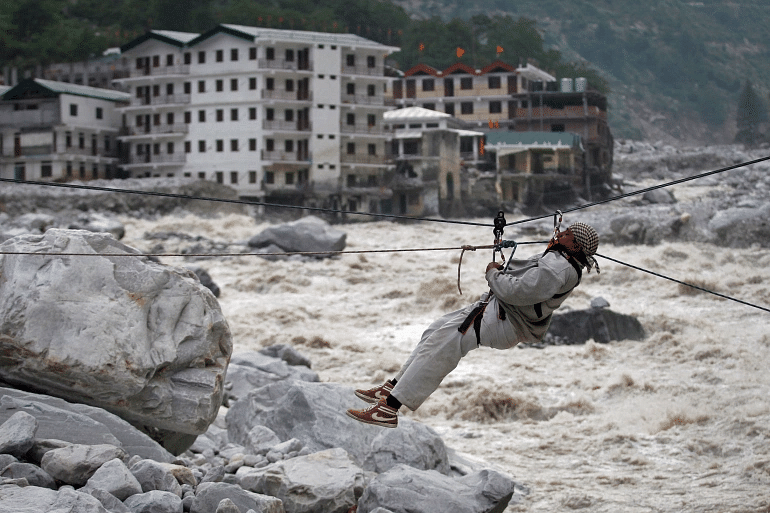Twenty bodies have been recovered and 197 persons are still missing after the glacier burst in Uttarakhand’s Chamoli district, officials said on Monday, as multiple agencies joined hands to rescue at least 30 workers trapped in a tunnel at a power project site.
With more bodies being recovered, the death toll touched 20 and could go higher, officials in the State Emergency Operation Centre here said, a day after a portion of the Nanda Devi glacier possibly burst through its banks at Joshimath. It appeared to have triggered an avalanche and a deluge that ripped through the Alaknanda river system in the upper reaches of the ecologically fragile Himalayas.
Experts, however, are still trying to determine the exact cause of the disaster in Joshimath. “It was due to lakhs of metric tonnes of snow sliding down abruptly from a trigger point on top of a naked hill,” Uttarakhand Chief Minister Trivendra Singh Rawat told reporters after meeting ISRO scientists.
After a comprehensive analysis is undertaken to find out the reasons, “we will build an elaborate plan to avert any potential tragedy going forward”, he said in an interview to PTI.
Prime Minister Narendra Modi assured a delegation of Uttarakhand MPs of his government’s support to the people of the state and said it is working to strengthen infrastructure there to deal with any natural disaster in future.
The 197 still missing include those working at hydel power project sites as well as villagers nearby whose homes were washed away with the force of the raging waters, the officials said.
Uttarakhand Chief Minister Trivendra Singh Rawat said saving lives and extending all help to the families of the deceased is the state government’s priority. Union ministers Ramesh Pokhriyal Nishank and R K Singh as well as Pauri MP Tirath Singh Rawat, Uttarakhand minister Dhan Singh Rawat also met the affected families in disaster-hit Tapovan and Raini and assured them of all support.
Two power projects – NTPC’s 480 MW Tapovan-Vishnugad project and the 13.2 MW Rishi Ganga Hydel Project – were extensively damaged with scores of labourers caught in tunnels as the waters came rushing in.
Rescue efforts in the affected areas near Joshimath, about 295 km from here, gained momentum with teams of the Army, Indo-Tibetan Border Police (ITBP), the National Disaster Response Force (NDRF) and State Disaster Response Force (SDRF) coordinating to rescue 30-35 people feared trapped in a tunnel at the Tapovan-Vishnugad project.
Sniffer dogs and heavy mechanical equipment, including bulldozers and JCBs, were deployed in the areas to aid the rescue workers.
While Indian Air Force teams left for the affected areas to ramp up relief efforts, personnel from multiple forces worked through the night.
The State Emergency Operation Centre said 27 people were rescued alive. Of these, 12 were saved from the smaller of the the two tunnels at the Tapovan-Vishnugad project site and 15 from the Rishi Ganga site.
Uttarakhand Director General of Police Ashok Kumar added that efforts were focussed on rescuing 30-35 labourers trapped in a 250-metre tunnel at Tapovan. Two villages are cut off and essentials are being supplied to them.
The work was complicated by the fact that the tunnel is slightly curved, making difficult to clear the slush, debris and silt blocking it.
The entire landscape was coloured a sandy grey, many structures swept away and buried under piles of silt.
“Our teams worked overnight to rescue about 30 workers who are trapped in the tunnel. Specialised equipment for such operations has been deployed. We are hopeful we will be able to rescue everyone,” ITBP spokesperson Vivek Kumar Pandey told PTI in Delhi.
“There is a huge amount of debris inside the tunnel. About 80 metres inside the tunnel is cleared and accessible, and it looks like about 100 more metres of debris will have to be cleared,” he added. Pandey said nearly 300 ITBP personnel are currently deployed at the site.
Another official said 34 people are estimated to be trapped in the ‘head race tunnel’ or HRT.
ITBP Additional Director General (Western Command) M S Rawat also reached the spot Monday morning to take stock of the situation and interacted with officials and others working at the site.
In a video provided by the force, a team of senior officials was seen analysing the tunnel’s map to find the best way of approach.
The tunnel has only one entry, an official said.
Teams of the NDRF had reached late Sunday night and were seen using shovels to clear the tunnel’s approach. The force also used canine squads to help rescuers detect traces of life under the debris.
More teams have been sent to the site on Mi-17 helicopters that landed at the helipad in Joshimath, NDRF chief S N Pradhan said in a Twitter post.
With no clarity on what led to the disaster and experts pointing to climate change, scientists also headed to Chamoli to understand what had happened.
Some teams from the Army, including from the Medical Corps, have also reached the disaster spot, a senior official supervising the operation said.
Three of those rescued on Sunday evening were admitted to the ITBP hospital at Joshimath, nearly 25 km from the Tapovan power project site, as they were feeling uneasy, the officials said. They are stable now.






